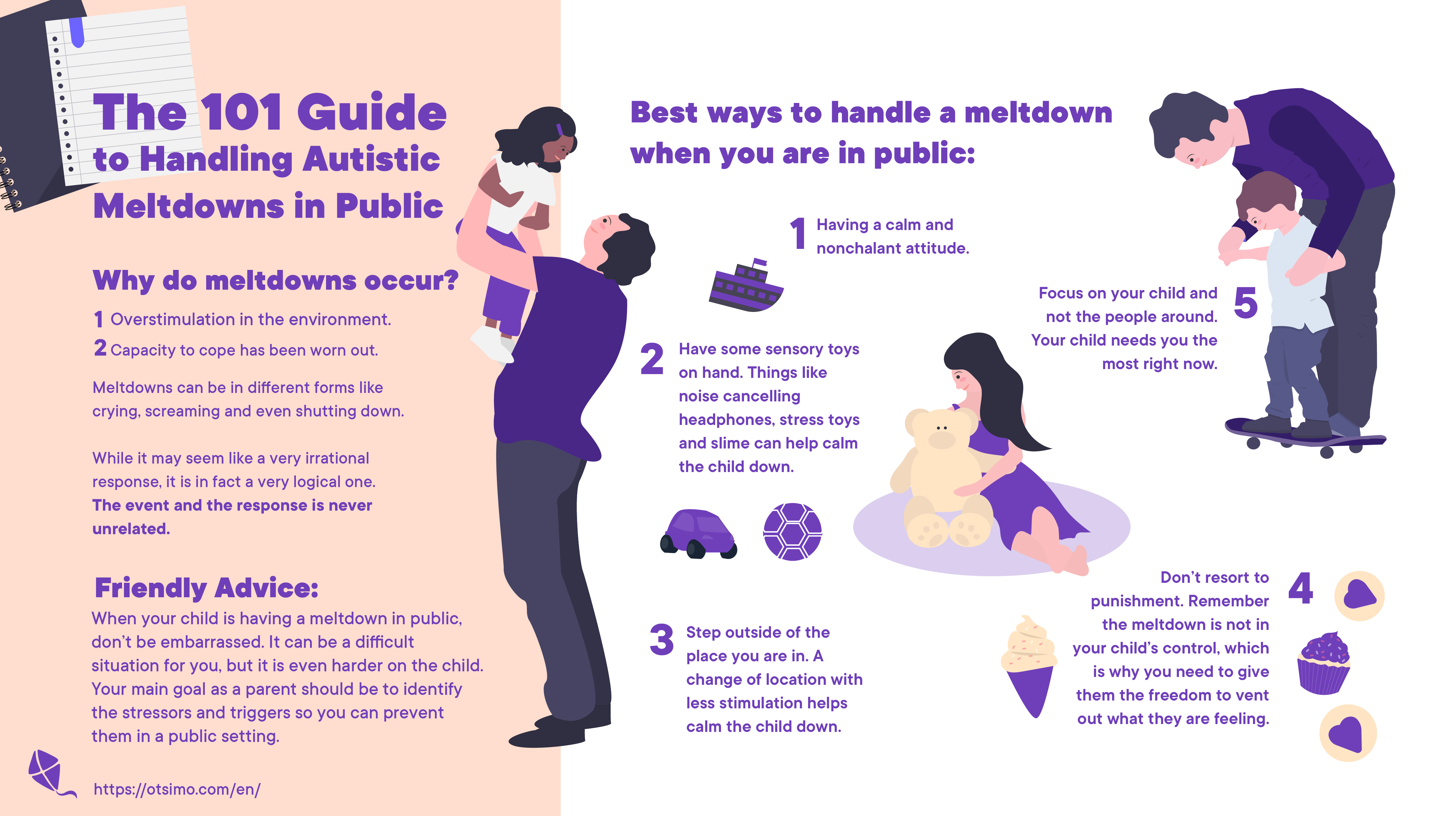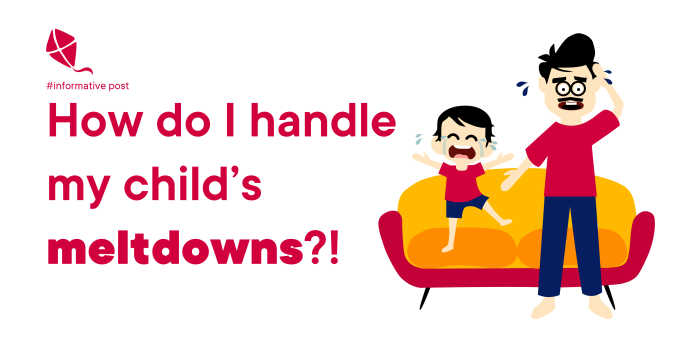It can get difficult to manage tantrums and meltdowns. Parents and caregivers who experience this, often wonder how to calm their autistic child.
We wanted to gather some information on what are meltdowns and tantrums, and how to deal with them.
What are the Causes of Meltdowns for Children with Autism?
We should first define what meltdown actually is. A meltdown is an intense response to overwhelming situations by the person.
This could happen when an individual is overwhelmed by the current situation. It could cause loss of control.
This can be exhibited in different manners. The loss of control shows through verbal expressions like yelling or crying, or it can be physical like kicking or biting.
There are cases where the response could be in both ways.
Here would be a good place to point out that autism meltdowns and temper tantrums are actually not the same thing.
When you are looking into ways on how to calm an autistic child, you may come across tantrums as well.
There may be a couple of underlying reasons for having a meltdown. It can be triggered by so many different problems.
The key to understanding how to calm an autistic child lies with understanding what it is that triggers the behavior.
The following are some of the common causes of meltdowns:
-
ADHD: Lack of focus or inability to tolerate boredom can contribute to outbursts
-
Learning issues: A learning disorder could cause frustration and lead to meltdowns
-
Anxiety: This is another major contributor. A child can get overwhelmed when faced with uncomfortable situations.
-
Sensory issues: Sensory issues cause children to feel overwhelmed which leads to meltdowns.
-
Lack of skills to handle situations: Children who lack the skills to cope with certain situations or emotions could experience meltdowns.
Meltdowns are not the only way that an individual with autism can show they are overwhelmed.
Less obvious ways include refusal to interact, or withdrawing oneself from challenging situations.
What is the Difference Between Meltdown and Tantrum?
They may seem similar on the outside. Externally, meltdowns and tantrums look really alike. But there are in fact differences between the two.
Tantrums can be seen in younger children as __willful__ behaviors. Not that children plan to frustrate their parents or caregivers, but they want to express their frustration.
However, a meltdown can be experienced throughout life. While tantrums tend to go away as the child gets older, meltdowns may never go away.
It is important to note that children with autism can, of course, have classic temper tantrums. But, understanding the difference between tantrums and meltdowns can provide great insight.
Tantrums can be resolved through a certain kind of response, while the same response can overwhelm the child during a meltdown.
If you are looking for ways on how to calm an autistic child, understanding the difference between meltdowns and tantrums can come in handy.
There are a couple of ways to figure out the difference between the two:
Audience: When ignored, tantrum behavior usually stops . Or when the child gets what they want, they may stop the behavior. But an autistic meltdown will occur regardless of an audience, as it is a response to an overload of external stimuli causing emotional explosion. This could even happen when they are alone.
Angry vs. Overwhelmed: Tantrums stem from being angry or frustrated. But autistic meltdowns are generally a reaction to being overwhelmed. Autistic individuals can’t control their meltdowns. Strategies like hugs, incentives or distractions that work on tantrums will not be beneficial for meltdowns.
Getting What They Want: Tantrums could be goal oriented. This means that a tantrum in a young child is typically a result of getting what they want. This could be a toy or not doing a certain routine or eating only a certain type of food. These tantrums can be more frequent when the child is tired or not feeling well, but there is generally a goal behind it.
However, autistic meltdown is caused by being overwhelmed.
Triggers include:
- Sensory overload
- Emotional overload
- Informational overload
The external behaviors like crying or yelling similar to tantrums may occur. Or they can completely shut down.
What Do Meltdowns Look Like?
Meltdowns can look different .) in each autistic person. The individual can withdraw, shut down, zone out, stare into space, or fall into repetitive movements.
They may also cry uncontrollably, scream, growl, bite, curl up into a ball.
Many individuals with autism will show signs of distress before having the meltdown. This is called the “ rumble state ”.
To calm themselves down, the individual may:
- Start pacing around,
- Ask repetitive questions,
- Rock back and forth,
- Become very still.
This could be the window to prevent a meltdown.
What Do Tantrums Look Like?
Tantrums differ from one child to another. They can be spectacular explosions of anger.
The child may “lose it” with frustration and disorganized behavior.
During tantrums , the child may cry, stiffen up, scream, kick things around, fall down or run away. Some children hold their breath, and some even vomit.
They may break things around the house. Children with autism could get aggressive when they are throwing a tantrum fit.
This is how autistic children may express their frustration with the challenges that they are facing.
Thirst , hunger, tiredness: Some examples that can lead to tantrums.
When they get frustrated, they get angry. And when they get angry, they can throw a tantrum.
Come along with 200k+ families!
Let's communicate better!
Download for Free.
How to Calm Down an Autistic Child During a Meltdown?
A meltdown is generally a reaction by the individual as they are overwhelmed. The first thing in learning how to calm an autistic child is to identify what is actually overwhelming for them.
By identifying the trigger, the meltdowns could be prevented later on. Keep a diary to see if meltdowns occur at particular times or places. However, there are also things to try while the autistic child is having a meltdown to calm them down. Here are some tips and strategies:
-
Have a calming routine: Although the meltdown could drain them of energy; having a calming routine in place for the autistic child could help them calm down further. This routine could include certain visuals that the child likes or music, or a weighted blanket they like.
-
Safety first: Meltdowns may unintentionally hurt both the child and others around them. Children with autism may, for instance, fall or hit their heads, or they could hit you or bite you. It may be a good idea to have a strategy in place to make it safe for the duration of the meltdown.
-
Keep a diary: Taking notes on when and where the meltdown occurs could help in preventing future ones. This could also be helpful in that you can see the signs of meltdown beforehand and start the calming routine to de-escalate the situation. If you understand what triggers meltdowns, you may be able to stop it beforehand.
-
Try to stay calm: It is important that you are not adding stress and escalating the situation more while your child is having a meltdown. They are tough, but meltdowns are part of autism. The best way to help is to learn to cope with them and have a strategy at hand.
-
Use items: Sometimes calming devices like a fidget toy could alleviate the effects.
-
Don’t be logical: Don’t try to reason with your child when they are having a meltdown. They are going through a stressful time as it is and they can’t be reasoned with until the meltdown is over. Be patient.
-
Always be there: Make sure that you are within reach of your child in case they want you during meltdown. Keep a neutral face and try to be calm.

How to Handle a Meltdown in Public
This can happen to anyone. Parents and caregivers could be low on patience while also hurting for their struggling child.
Remember that autistic children do not have meltdowns and cry or flail just to get at you.They cry because they need to release tension from their bodies in some way. They are overwhelmed with emotions or sensory stimulations.
There are some ways to effectively support your child when they are having a meltdown in public. Here are some of them.
Equip them with coping skills: Meltdowns can’t be helped at that very moment. But afterwards, you can teach your child how to regulate their emotions. Try relaxing activities like going for walks. These calming activities will help them calm down even before the meltdown happens.
Feeling safe and loved: Trying to talk a child down from having a meltdown is not a great strategy when it comes to calm an autistic child. Be there for them. Let them know that they are safe at that moment. Stay close as much as their comfort allows. Don’t leave them alone to be out of a meltdown and find no one in the room. This could send a message that they don’t deserve to be around the people they love when it gets tough.
Empathy is key: Listen and understand their situation. Tell them expressing emotions is okay, and sometimes it can get overwhelming. If your child with autism can feel like they are being heard, they will feel that their experience is validated. Try to give them tools to express themselves in a safe way.
Don’t punish: Punishment will get you nowhere. They can make your child feel more ashamed or afraid. They can’t control their meltdowns, so they should not be punished. Allow them the opportunity and space to feel their feelings and let them know you are there to support them along the way.
Have a sensory toolkit: You can keep a couple of sensory toys in your bag when you are going out. These will keep the mind of your child occupied when they are overwhelmed. Try not to force these to the child during meltdown.
What to Do When My Child is Having a Tantrum?
1. Tantrum vs. Meltdown
Before you intervene in any way, try to figure out whether your child is having an autism meltdown or tantrum. As we discussed earlier, they may look similar but they need different approaches.
Meltdowns are a response to external stimulation, while tantrums can occur when a need is not being met.
It is important to distinguish the two before having a strategy to manage the situation.
2. Figure out the motivation
Understanding what lies behind the tantrum behavior will give you the key to manage it.
You will be able to respond to it more appropriately. They may want something, like a toy or attention. Recognize this want without giving it to them.
3. Remove the audience
Sometimes removing the audience from the environment, the tantrum will stop. If you noticed this pattern, like your child tends to have tantrums in crowded areas, teach them coping mechanisms in small gatherings.
Try removing yourself from the environment (but still being a place where they can see you). It could also help reduce and stop tantrum.
4. Praise and reinforce positive behavior
Acknowledge the feelings of your child and praise them for their good behavior.
You can give them a hug, or tell them how they managed to do the thing well. These will avoid tantrum outbursts as your child will learn that they have your attention and can be successful in doing things.
5. Build the necessary skills
We have discussed before that tantrums can be caused by lack of certain skills like problem solving or negotiating.
Try to create opportunities to build on skills related to:
- impulse control,
- communicating wishes and needs,
- self-soothing,
- problem solving,
- delaying gratification
- negotiation.
You can try practicing them after tantrums.
Sensory Tools for Meltdowns
You can prepare a toolkit to take anywhere you go, in your car or in your bag, consisting of sensory tools to utilize during meltdowns. They will be able to help on some level. Here are some suggestions to put in your toolkit .
-
Noise-cancelling headphones. A pair of noise cancelling headphones can help calm an autistic child when the noise gets too loud for them.
-
Sunglasses. If your child has light sensitivity, a pair of sunglasses can help them when it is too sunny or the fluorescent lights are too bright.
-
Weighted blanket/lap pad. Pressure can be an answer to how to calm an autistic child. Weighted blankets and lap pads.
-
Snacks that are chewy or crunchy. Kids get crankier when they are hungry. Crunchy ones can help with oral proprioceptive input as a calming effect. Or if your child likes chewy snacks, they are another way to go.
-
Fidget toy. These are repetitive and simple tools that can offer calmness to your child when they get agitated.
-
Scented hand lotion. If some odors in the environment is too much for your child, you can use a hand lotion with a scent the child likes.
-
Hand wipes. Children with tactile sensitivities can accidentally touch something that can irritate them. These unscented hand wipes may help with this.
Tips from Other Parents of Children with Autism
Not all meltdowns and tantrums look the same on all children. Some of the tips and tricks as well as strategies mentioned in this article may not be suitable for your child while they can be helpful to others.
Remember that you are not alone. Tantrums and meltdowns are common in children with autism. You can get inspiration or support from other parents who are also dealing with this same issue.
The first thing parents suggest is to understand the difference between tantrums and meltdowns. They have noticed that when their child is having a meltdown, there is usually a trigger. They try to make a safe environment, like taking the child to their room, so that the child will not hurt themselves.
From what the parents or caregivers explain, sometimes the child can also select a place like a dark closet to have a meltdown where no one can reach them. But the parents always stay close and when the child is more comfortable, they try to help and comfort their child.
In the case of tantrums, sensory overload is generally not an issue. You should be looking for the motivation behind the tantrums. Parents state that tantrums don’t last as long as the meltdowns. Reinforcement and praise of positive behavior at this stage helped a lot of parents.
A popular method for soothing the meltdown used by a lot of parents and caregivers is weighted blankets and pressure. These have proven to be effective in calming the child down. Some stated that as their child got older, they managed to teach the child breathing exercises as well to help them self-sooth.
Another tip from the parents is related to stimming. There are some stim toys and fidgets the child can use. Make sure to keep a couple around and have them be something the child is interested in. Parents suggest that if you can catch the meltdown at its early stages with these stim and fidget toys, it becomes much easier to stop it.
Parents or loved ones of the child with autism also have suggestions on making the environment safer for when the child is having a meltdown. You can remove items that can hurt them and cushion their surroundings by putting a pillow if they start to bang their heads. They suggest trying not to speak to them or touching them during the meltdown as this may make things worse.
Also, parents and caregivers state that children feel exhausted and embarrassed after the meltdown is over. Try to convey them that you understand how they feel and ask them if they want a cuddle or a glass of water.
You can also speak to your child about their feelings, and let them know it is okay to have those feelings.
Last Updated: 23 December 2022





